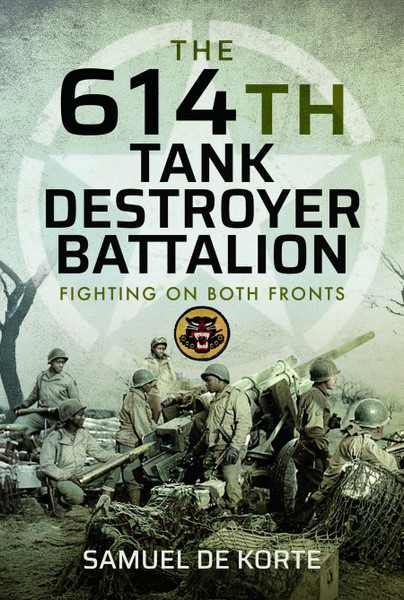Author Guest Post: Samuel de Korte
Third Platoon, C Company, 614th Tank Destroyer Battalion and the Battle of Climbach (14 December 1944).
“the most magnificent display of mass heroism I have ever witnessed”
On 14 December 1944, a small task force was assembled under the command of Lieutenant Colonel Blackshear. This task force consisted of a reinforced infantry company from the 103rd Infantry Division, a platoon of tanks, and a platoon of four tank destroyers: Third Platoon, C Company, 614th Tank Destroyer Battalion. The purpose of this task force? To capture the strategic town of Climbach, France. According to information, derived from German prisoners of war, it was lightly defended. However, as soon as the American soldiers approached the town, it turned out that the German forces were well dug in and determined to hold Climbach. The platoon of tank destroyers deployed on the reverse slope of a hill and afterward, the ferocity of the tank destroyer platoon was described by Lieutenant Colonel Blackshear as follows: “The unflinching determination of this small group constituted the most magnificent display of mass heroism I have ever witnessed.”

Task Force Blackshear
On 14 December, Task Force Blackshear set out to capture the town of Climbach. While approaching the town, Lieutenant Charles L. Thomas was driving in the lead vehicle. As he topped the rise outside of town, his vehicle struck a mine and was hit by an antitank gun. Although wounded and hit by a machine gun, Thomas was not dismayed and he deployed two of his tank destroyers. They were joined shortly afterward by the other two guns. A fierce battle erupted, wherein the Germans desperately tried to eliminate the platoon of tank destroyers. However, the tank destroyers, reinforced by a platoon of infantry, would not budge and continued to fire on the town.

Tank Destroyer crews don’t last long in an open field
However, tank destroyer crews don’t last long in an open field in front of the enemy. Casualties started mounting rapidly and one soldier ran between two guns, aiming and firing them, while the rest of the crew served alongside the infantry platoon. However, their numbers dwindled under the enemy fire. A while later only one gun, under the command of Sergeant Dillard L. Booker, continued to fire and that gun was running low on ammunition. A half-track driver, Robert Harris, was not dismayed by the hostile artillery and warnings from Lieutenant Colonel Blackshear about the potential danger, and Harris drove his half-track across the field towards the remaining gun. Once the half-track became stuck in the mud, Harris unloaded the ammunition by hand and ran across the field to deliver the ammunition. By doing this, he allowed Booker’s gun to continue firing.

More than fifty percent casualties
Meanwhile, the company of infantry moved to encircle Climbach. They eventually managed to reach the town and once they had seized it, Booker’s gun ceased firing. As soon as the fighting was over, the men had time to look around and assess the battle. It turned out that three of the four guns, two half-tracks, two jeeps, and a scout car were knocked out of action. Four soldiers were killed and fifteen soldiers were wounded. More than half of the platoon had become a casualty. This included Charles L. Thomas, the commander of C Company, who refused to be evacuated until another officer was present to take over the situation.

Charles L. Thomas was posthumously awarded the Medal of Honor
Third Platoon, C Company, 614th Tank Destroyer Battalion, was awarded the Distinguished Unit Citation (now known as Presidential Unit Citation). The platoon also received four Silver Star Medals and nine Bronze Star Medals for the battle of Climbach. Charles L. Thomas was initially awarded the Distinguished Service Cross, the second Black American to receive this award during the Second World War. In 1992 the Distinguished Service Cross was rescinded and Charles Thomas was posthumously awarded the Medal of Honor, being one of the seven Black Americans to receive this reward.
The fragment above is just a glimpse into the history of the 614th Tank Destroyer Battalion. The unit has fought valiantly during the Second World War and to discover more about this outfit, we recommend checking out Samuel de Korte’s The 614th Tank Destroyer Battalion: Fighting on Both Fronts.


